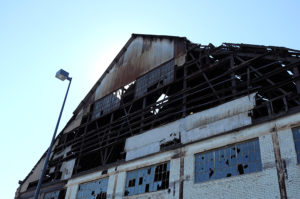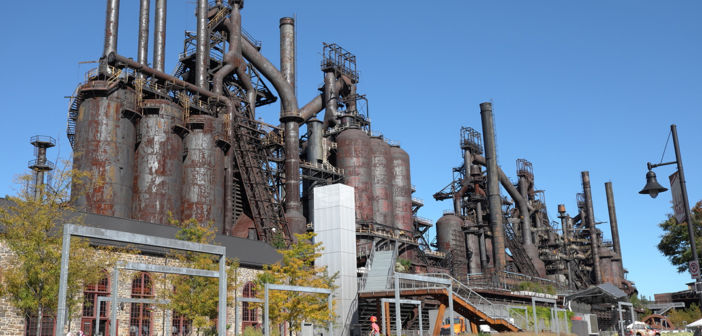
An abandoned building decays at the site of the Bethlehem Steel plant on Monday, Oct. 10, 2016. Many people lost their jobs when Bethlehem Steel closed. (Tiancheng Ji/B&W Staff)
Bethlehem Steel was once widely known as a major industrial site and the second largest steel producer in the country. However, a large part of the history of the Bethlehem Steel and its steel labor force lies in the hands of the Latin-American laborers, who made long-lasting contributions in their South Side workplace.
Hispanic Heritage Month is celebrated between Sept. 15 and Oct. 15 and those in the Bethlehem community observe the contributions of Latin-American Bethlehem Steel workers from the Lehigh Valley.
Lehigh University hosts a website, Beyond Steel, which includes a variety of excerpts and interviews describing the experiences of those who worked and lived in the Lehigh Valley when it was a booming, steel-producing community.
An important part of Beyond Steel is the Bethlehem Steelworkers’ Archives. Jill Schennum, a board member of Steelworkers’ Archives, said the archive is a not-for-profit organization that, among other things, collects oral histories from ex-steelworkers.
“Latin-American, or Latino labor, was a very important part of the steel labor force,” Schennum said. “A lot of people don’t know that there is this long history, since the 1920s, of Mexican-American workers and since the 1940s, of Puerto Rican workers, in the steel mill.”
Schennum stressed that Latino workers both dedicated their time to working at Bethlehem Steel and made a huge contribution to their neighborhood.
Mexican workers started a club on the South Side called “Cluba Azteca,” which became an important center for occasions like burials, benefits and fundraising events. When the Puerto Rican population came to Bethlehem, it started its own ethnic club, the Puerto Rican Beneficial Association, which succeeded in making conditions better for the community and for Puerto Rican workers.
Among Schennum’s research are her interviews. She interviewed a variety of people for the Steelworkers’ Archives, including two Latina workers, Iris Linares and Bernadette Misero.
Linares was the daughter of a skilled Bethlehem Steel worker, Schennum said. She worked at Durkee Foods, a food manufacturer chartered by the United Steelworkers of America, and became a union official with the United Steelworkers. In the interview, Linares explains her childhood, her father’s working experience and her own working experience.
Misero worked at Bethlehem Steel as an escort. Her position was similar to that of a receptionist, by escorting visitors to offices and working the elevators. In her interview, she expresses her passion for the position that she held at the steel mill.
At the heart of the South Side rests Lehigh University, and members of the Lehigh community are also celebrating Hispanic Heritage Month.
“My organization wanted to have a huge celebration party for the month,” said Kristen Mejia, ’17, a member of Lambda Theta Alpha sorority. “Knowing that there are many other Latinx-based organizations on campus, we started to reach out to them. We partnered with the Latino Student Alliance, Latin Dance, Society of Hispanic Professional Engineers, Lambda Theta Alpha Latin sorority, Mu Sigma Upsilon sorority, Spanish Club and African Caribbean Culture Club to put together this event.”
Mejia explained “Latinx” is a more inclusive word that is being used more often. Latino is a word that is male-centered, and Spanish itself is a gendered language. She said if someone does not use the pronouns she/her/hers or him/his/he then they use “x” to acknowledge there is gender fluidity and that there is a spectrum of gender as well.
The event, Latinx Fiesta, was held Sept. 30. Members taught different dances, like salsa and cumbia, had Latinx food and even a piñata. Fredy Ramirez, ’19, said there were also discussions held to talk about their culture and that many offices on campus helped promote their events and even added insightful information and perspectives to their traditions.
“We want people to feel welcomed in joining us for our traditions,” Ramirez said. “Hispanic Heritage Month may only be from September to October, but we want to take pride and joy in our culture throughout the year.”






Comment policy
Comments posted to The Brown and White website are reviewed by a moderator before being approved. Incendiary speech or harassing language, including comments targeted at individuals, may be deemed unacceptable and not published. Spam and other soliciting will also be declined.
The Brown and White also reserves the right to not publish entirely anonymous comments.